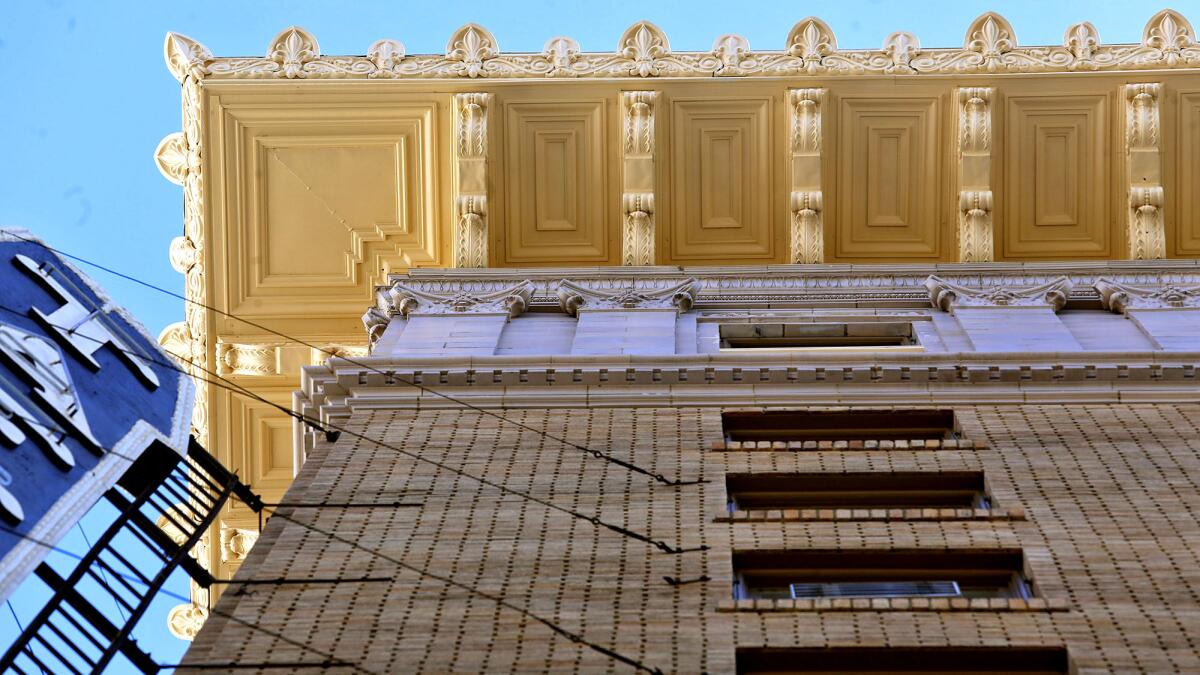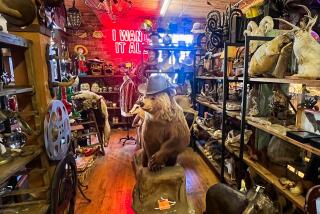Taft Building, an aging Hollywood hot spot, gets a makeover

Hollywood’s first high-rise office building has been restored to its former glory, buttressing the ongoing revival of the legendary intersection of Hollywood and Vine.
The Taft Building, opened in 1924, has undergone a $15-million renovation that shored up its seismic strength and uncovered historic architectural details that were under wraps for decades.
------------
FOR THE RECORD
Jan. 29, 7:18 a.m.: A photo caption in an earlier version of this article stated that the Taft Building is at Hollywood and Highland. It is located at Hollywood and Vine.
------------
The 12-story building has been home to major film studios, the Academy of Motion Picture Arts and Sciences and such show biz luminaries as Charlie Chaplin and Will Rogers. Scores of agents and publicists set up shop there when the storied Brown Derby Hollywood restaurant was a few steps from the front door.
“I definitely feel a sense of connection to history,” said tenant Kerry Morrison, executive director of the Hollywood Property Owners Alliance. “I wonder who was in our office 20, 40 or 60 years ago — and sometimes I wonder what it was like here in the 1930s when there was no air conditioning.”
A 1980s renovation by previous owners added window-unit air conditioners and other changes considered improvements at the time, such as dropped ceilings, new flooring and wall coverings. But the changes obscured the building’s original features.
Owner DLJ Capital Partners restored the building inside and out, exposing windows and brick walls that had been hidden for years. Decorative marble and terra cotta features were restored and new lighting and plumbing were installed. Central heating and air conditioning is being phased in as tenants move.
“We exposed concrete ceilings, found polished concrete floors and beautiful brick,” said Andy Rifkin, managing partner of DLJ.
Such features were out of favor in the 1980s, but they are back in vogue with many tenants in creative fields such as technology and entertainment — exactly the group DLJ hopes to reach.
“What we found is what everybody wants,” Rifkin said. “It’s got this historic feel and authentic materials.”
DLJ bought the building for $28.5 million in late 2011, he said, in part because improvements in Hollywood’s real estate landscape reminded him of successful pockets of transformation in such New York neighborhoods as the Bowery, Williamsburg and the Flatiron District.
“Our investment strategy is to look for those pockets,” Rifkin said.
The Taft Building at 1680 N. Vine St. is also near a large-scale apartment complex called Eastown that DLJ is developing on Hollywood Boulevard. The first phase of 535 units has been completed and an additional 507 units are set to open in 2017.
“We are very bullish on the area,” Rifkin said.
The Taft Building has a space on the ground floor that DLJ hopes to rent to an upscale restaurant. A door on Hollywood Boulevard leads to a basement that could be turned into a speak-easy-style bar, he said.
Such a bar would have been illegal when developer Alfred Z. Taft set out to build the city’s first high-rise outside of downtown Los Angeles. During Prohibition, Hollywood and Vine was a bucolic spot occupied by an ivy-clad Methodist Church, a large house and a five-acre orange grove.
The building was designed in Neo-Renaissance style by prominent architects Percy A. Eisen and Albert R. Walker, who are also known for designing the Fine Arts Building and the James Oviatt Building in downtown Los Angeles and the Beverly Wilshire Hotel in Beverly Hills.
The first three office floors of the Taft Building were intended to house doctors and dentists, The Times reported in 1924. It had 252 separate offices and suites, 684 windows and 10 stores. It was built of concrete and bricks.
“If all the bricks were placed end to end in a single line they would reach from Hollywood to Santa Barbara,” The Times said, “a distance of 105 miles.”
Other commercial development followed the Taft Building to Hollywood and Vine, including the Broadway Hollywood department store and the Hollywood Equitable Building office tower. Both structures remain and have been converted to residential use.
Offices are in rising demand in Hollywood, however, said real estate broker Carle Pierose of Industry Partners, the building’s leasing agent.
“Hollywood has been on fire,” he said, much improved from the 1980s and 1990s when entertainment companies were abandoning the neighborhood. Now developers are building major office complexes on spec, or without tenants, on Sunset Boulevard and an additional 1,000 apartments are expected to come on line near the Taft.
The Taft is flanked by the $500-million W hotel, condominium, apartment and retail complex. The extended-stay Redbury Hotel opened to the north in 2010, just a piece of the $4.8 billion that developers have spent in Hollywood since 2000.
An additional $1 billion worth of projects are under construction in the neighborhood, and developments worth an additional $1.6 billion are in the pipeline, according to the Hollywood Property Owners Alliance.
“Hollywood is not a big market,” Pierose said, “but what’s happening there is amazing.”







